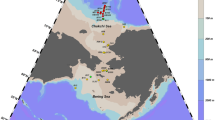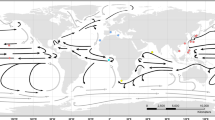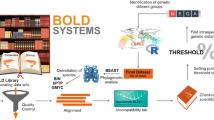Abstract
Squids of the family Onychoteuthidae are ecologically important in pelagic food webs and have been reported from every ocean except the Arctic. Although they are abundant and caught frequently as bycatch in fisheries, the biogeography of many species remains poorly understood. Species identification within the Atlantic Ocean is usually restricted to two species: Onychoteuthis banksii and Onykia carriboea. Here, we report the occurrence of four species of the family Onychoteuthidae (Onychoteuthis cf. banksii, Onykia carriboea, Walvisteuthis jeremiahi, and Onychoteuthis sp. AL 2) from the Sargasso Sea in the western Atlantic, identified using DNA barcoding (cytochrome c oxidase subunit I) and morphology. Our results have doubled the known onychoteuthid biodiversity in the Sargasso Sea, which has implications for the ecology of this oceanic region.

Similar content being viewed by others
References
Allcock, A. L., I. Barratt, M. Eléaume, K. Linse, M. D. Norman, P. J. Smith, D. Steinke, D. W. Stevens & J. M. Strugnell, 2011. Cryptic speciation and the circumpolarity debate: a case study on endemic Southern Ocean octopuses using the COI barcode of life. Deep Sea Research Part II 58: 242–249.
Arkhipkin, A. I. & C. M. Nigmatullin, 1997. Ecology of the oceanic squid Onychoteuthis banksii and the relationship between the genera Onychoteuthis and Chaunoteuthis (Cephalopoda: Onychoteuthidae). Journal of the Marine Biological Association of the United Kingdom 77: 839–869.
Bolstad, K. S., 2008a. Systematics of the Onychoteuthidae Gray, 1847 (Cephalopoda: Oegopsida). Auckland University of Technology, https://aut.researchgateway.ac.nz/handle/10292/414.
Bolstad, K. S., 2008b. Two new species and a review of the squid genus Onychoteuthis Lichtenstein, 1818 (Oegopsida: Onychoteuthidae) from the Pacific Ocean. Bulletin of Marine Science 83: 481–529.
Bolstad, K. S. R., 2010. Systematics of the Onychoteuthidae Gray, 1847 (Cephalopoda: Oegopsida). Magnolia Press, Auckland, N.Z.
Bolstad, K. S. R., M. Vecchione & R. E. Young, 2010. Onychoteuthidae Gray, 1847. Hooked Squids. http://tolweb.org/Onychoteuthidae.
Boyle, P. & P. Rodhouse, 2005. Cephalopods as prey. Cephalopods – Ecology and Fisheries. Blackwell Publishing, Oxford.
Braid, H. E. & K. S. R. Bolstad, 2015. Systematics of the Mastigoteuthidae Verrill, 1881 (Cephalopoda: Oegopsida) from New Zealand waters. New Zealand Journal of Zoology 42: 187–256.
Braid, H. E., P. D. McBride & K. S. Bolstad, 2014. Molecular phylogenetic analysis of the squid family Mastigoteuthidae (Mollusca, Cephalopoda) based on three mitochondrial genes. Hydrobiologia 725: 145–164.
Bruno, J. F. & M. I. O’Connor, 2005. Cascading effects of predator diversity and omnivory in a marine food web. Ecology Letters 8: 1048–1056.
Bucklin, A., D. Steinke & L. Blanco-Bercial, 2011. DNA barcoding of marine metazoa. Annual Review of Marine Science 3: 471–508.
Carlson, C. A., H. W. Ducklow & A. F. Michaels, 1994. Annual flux of dissolved organic carbon from the euphotic zone in the northwestern Sargasso Sea. Nature 371: 405–408.
Cherel, Y. & H. Weimerskirch, 1999. Spawning cycle of onychoteuthid squids in the southern Indian Ocean: new information from seabird predators. Marine Ecology Progress Series 188: 93–104.
Dai, L., X. Zheng, L. Kong & Q. Li, 2012. DNA barcoding analysis of Coleoidea (Mollusca: Cephalopoda) from Chinese waters: DNA Barcoding of coleoid species. Molecular Ecology Resources 12: 437–447.
Darriba, D., G. L. Taboada, R. Doallo & D. Posada, 2012. jModelTest 2: more models, new heuristics and parallel computing. Nature Methods 9: 772.
De Silva-Dávila, R., C. Franco-Gordo, F. Hochberg, E. Godínez-Domínguez, R. Avendaño-Ibarra, J. Gómez-Gutiérrez & C. Robinson, 2015. Cephalopod paralarval assemblages in the Gulf of California during 2004–2007. Marine Ecology Progress Series 520: 123–141.
Diekmann, R. & U. Piatkowski, 2002. Early life stages of cephalopods in the Sargasso Sea: distribution and diversity relative to hydrographic conditions. Marine Biology 141: 123–130.
Griffin, J. N., K. L. De La Haye, S. J. Hawkins, R. C. Thompson & S. R. Jenkins, 2008. Predator diversity and ecosystem functioning: density modifies the effect of resource partitioning. Ecology 89: 298–305.
Hanner, R., 2005. Proposed standards for BARCODE records in INSDC (BRIs). Database Working Group, Consortium for the Barcode of Life
Ivanova, N. V., A. V. Borisenko & P. D. Hebert, 2009. Express barcodes: racing from specimen to identification. Molecular Ecology Resources 9: 35–41.
Judkins, H. L., M. Vecchione & C. F. Roper, 2009. Cephalopoda (Mollusca) of the Gulf of Mexico. In Felder, D. L. & D. K. Camp (eds), Gulf of Mexico-Origins, Waters, and Biota. Biodiversity. Texas A&M University Press, College Station: 701–709.
Kubodera, T., U. Piatkowski, T. Okutani & M. R. Clarke, 1998. Taxonomy and zoogeography of the family Onychoteuthidae. Smithsonian Contributions to Zoology 586: 277–291.
Laptikhovsky, V., P. Boersch-Supan, K. Bolstad, K. Kemp, T. Letessier & A. D. Rogers, 2015. Cephalopods of the Southwest Indian OceanRidge: a hotspot of biological diversity and absence of endemism. Deep Sea Research Part II. doi:10.1016/j.dsr2.2015.07.002.
Leach, W. E., 1817. Synopsis of the orders, families, and genera of the class Cephalopoda. The Zoological Miscellany 1817: 137–141.
Lesueur, C. A., 1821. Description of several new species of Cuttlefish. Journal of the Academy of Natural Sciences of Philadelphia 2(1): 86–101.
Lindgren, A. R., 2010. Molecular inference of phylogenetic relationships among Decapodiformes (Mollusca: Cephalopoda) with special focus on the squid order Oegopsida. Molecular Phylogenetics and Evolution 56: 77–90.
Lischka, A., 2015. Cephalopods of the Sargasso Sea-distribution patterns in relation to hydrographic conditions. Christian-Albrechts-Universität Kiel, http://eprints.uni-kiel.de/31706/.
Lu, C. C. & M. R. Clarke, 1975. Vertical distribution of cephalopods at 11 N, 20 W in the North Atlantic. Journal of the Marine Biological Association of the United Kingdom 55: 369–389.
Meier, R., G. Zhang & F. Ali, 2008. The use of mean instead of smallest interspecific distances exaggerates the size of the “barcoding gap” and leads to misidentification. Systematic Biology 57: 809–813.
Nesis, K. N., 1987. Cephalopods of the world: squids, cuttlefishes, octopuses, and allies. http://agris.fao.org/agris-search/search.do?recordID=XF2015011375.
Piatkowski, U., G. J. Pierce & M. M. Da Cunha, 2001. Impact of cephalopods in the food chain and their interaction with the environment and fisheries: an overview. Fisheries Research 52: 5–10.
Pierce, G. J., J. Wang, X. Zheng, J. M. Bellido, P. R. Boyle, V. Denis & J.-P. Robin, 2001. A cephalopod fishery GIS for the Northeast Atlantic: development and application. International Journal of Geographical Information Science 15: 763–784.
Rambaut, A., 2012. FigTree v1. 4. University of Edinburgh, Edinburgh.
Ratnasingham, S. & P. D. Hebert, 2007. BOLD: The Barcode of Life Data System (http://www.barcodinglife.org). Molecular ecology notes 7: 355–364.
Riemann, L., T. G. Nielsen, T. Kragh, K. Richardson, H. Parner, H. H. Jakobsen & P. Munk, 2011. Distribution and production of plankton communities in the subtropical convergence zone of the Sargasso Sea. I. Phytoplankton and bacterioplankton. Marine Ecology Progress Series 426: 57–70.
Rodhouse, P. G. & C. M. Nigmatullin, 1996. Role as consumers. Philosophical Transactions of the Royal Society of London B Biological Sciences 351: 1003–1022.
Rosa, R., H. M. Dierssen, L. Gonzales & B. A. Seibel, 2008. Large-scale diversity patterns of cephalopods in the Atlantic open ocean and deep sea. Ecology 89: 3449–3461.
Santos, M. B., M. R. Clarke & G. J. Pierce, 2001. Assessing the importance of cephalopods in the diets of marine mammals and other top predators: problems and solutions. Fisheries Research 52: 121–139.
Stachowicz, J. J., J. F. Bruno & J. E. Duffy, 2007. Understanding the effects of marine biodiversity on communities and ecosystems. Annual Review of Ecology, Evolution, and Systematics 38: 739–766.
Strugnell, J. M. & A. R. Lindgren, 2007. A barcode of life database for the Cephalopoda? Considerations and concerns. Reviews in Fish Biology and Fisheries 17: 337–344.
Sweeney, M. J., C. F. E. Roper & K. M. Mangold, 1992. Larval and juvenile cephalopods: a manual for their identification: proceedings of a workshop organized by the Cephalopod International Advisory Council (CIAC), held at Laboratoire Arago, Banyuls-sur-Mer, France, 17–28 June 1985. Smithsonian contributions to zoology http://library.wur.nl/WebQuery/clc/558980.
Tamura, K. & M. Nei, 1993. Estimation of the number of nucleotide substitutions in the control region of mitochondrial DNA in humans and chimpanzees. Molecular biology and evolution 10: 512–526.
Tamura, K., J. Dudley, M. Nei & S. Kumar, 2013. MEGA6: molecular evolutionary genetics analysis (MEGA) software version 6.0. Molecular biology and evolution 24(8): 1596–1599. Advance Access published May 7. Oxford University Press.
Vecchione, M., A. Sosnowsk & R. E. Young, 2015. Walvisteuthis jeremiahi n. sp. (Mollusca: Cephalopoda), an onychoteuthid squid from the Gulf of Mexico. Proceedings of the Biological Society of Washington 128: 164–175.
Voorhis, A. D. & J. B. Hersey, 1964. Oceanic thermal fronts in the Sargasso Sea. Journal of Geophysical Research 69: 3809–3814.
Wakabayashi, T., N. Suzuki, M. Sakai, T. Ichii & S. Chow, 2006. Identification of ommastrephid squid paralarvae collected in northern Hawaiian waters and phylogenetic implications for the family Ommastrephidae using mtDNA analysis. Fisheries Science 72: 494–502.
Young, R. E. & R. F. Harman, 1987. Descriptions of the larvae of three species of the Onychoteuthis banksii complex from Hawaiian waters. Veliger 29: 313–321.
Young, R. E., M. Vecchione & K. M. Mangold, 2012. Cephalopoda Cuvier 1797 Octopods, squids, nautiluses, etc. The Tree of Life Web Project, http://tolweb.org/Cephalopoda.
Zemlak, T. S., R. D. Ward, A. D. Connell, B. H. Holmes & P. D. Hebert, 2009. DNA barcoding reveals overlooked marine fishes. Molecular Ecology Resources 9: 237–242.
Zhang, J., P. Kapli, P. Pavlidis & A. Stamatakis, 2013. A general species delimitation method with applications to phylogenetic placements. Bioinformatics 29: 2869–2876.
Zwickl, D. J., 2006. GARLI: genetic algorithm for rapid likelihood inference. See http://www.bio.utexas.edu/faculty/antisense/garli/Garli.html.
Acknowledgements
We would like to thank Dr. Reinhold Hanel for providing the material collected during the two cruises. Thanks also to the captain and crew of RV Maria S. Merian and FRV Walther Herwig III for their skilful support. The ship cruise was funded by the Deutsche Forschungsgemeinschaft (Grant MerMet 14-46 (SEA-EELS)). We would like to thank the Roche Lab for their assistance with our molecular work and the Auckland University of Technology for funding the barcoding project.
Author information
Authors and Affiliations
Corresponding author
Additional information
Guest editors: Erica A. G. Vidal, Ian G. Gleadall & Natalie Moltschaniswskyi / Advances in Cephalopod Ecology and Life Cycles
Electronic supplementary material
Below is the link to the electronic supplementary material.
Rights and permissions
About this article
Cite this article
Lischka, A., Braid, H.E. & Bolstad, K.S.R. DNA barcoding from the hooked squids (Cephalopods: Onychoteuthidae) of the Sargasso Sea. Hydrobiologia 808, 107–113 (2018). https://doi.org/10.1007/s10750-017-3189-0
Received:
Revised:
Accepted:
Published:
Issue Date:
DOI: https://doi.org/10.1007/s10750-017-3189-0




